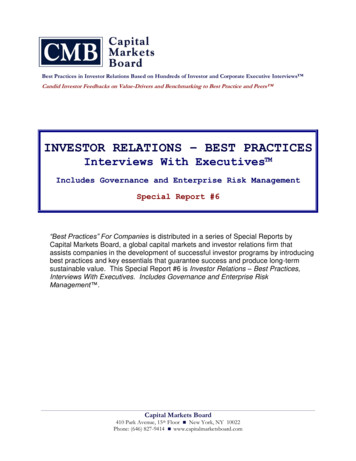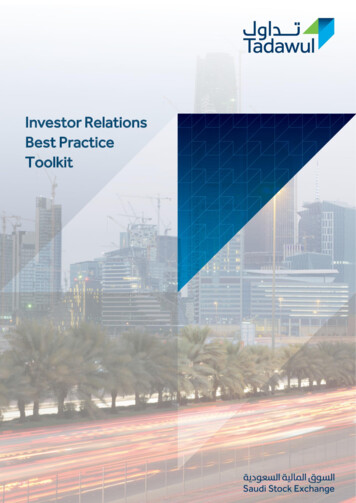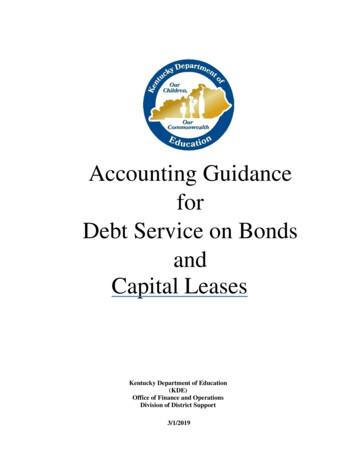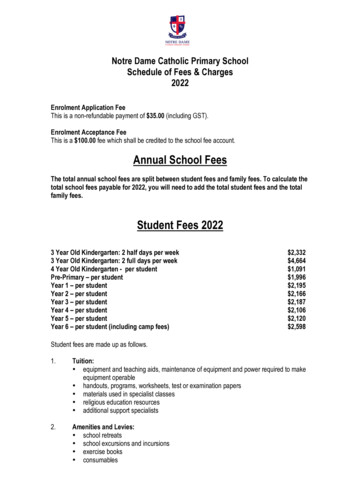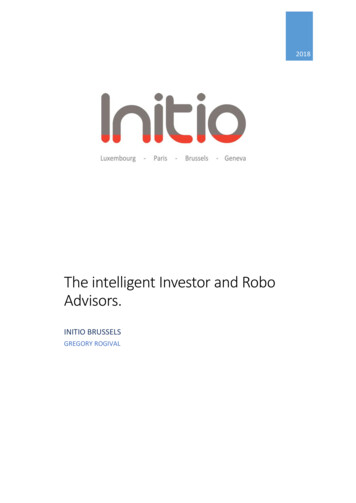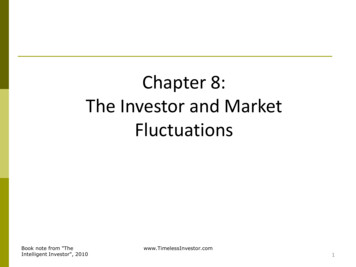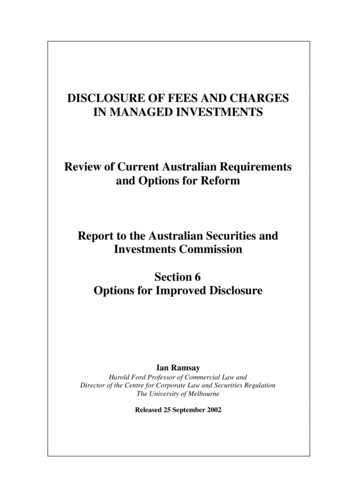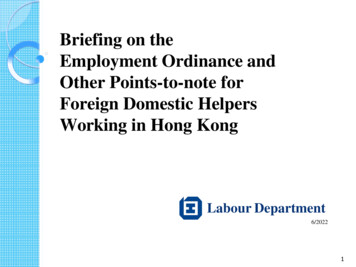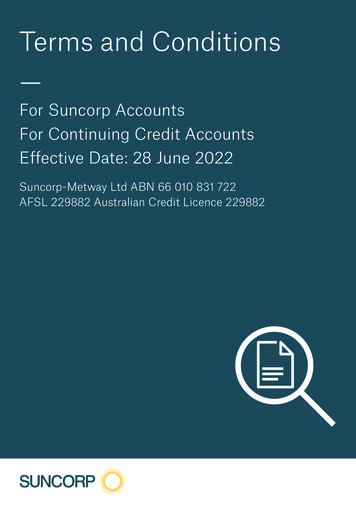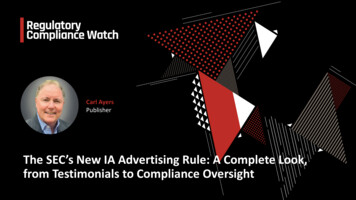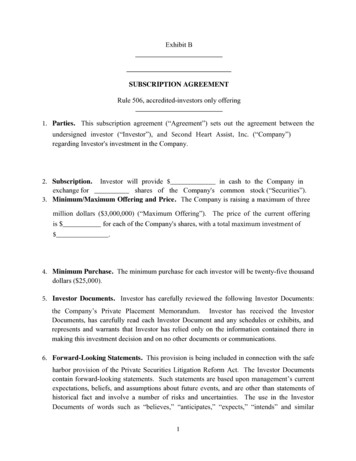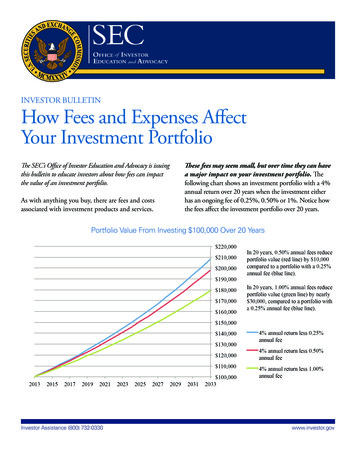
Transcription
INVESTOR BULLETINHow Fees and Expenses AffectYour Investment PortfolioThe SEC’s Office of Investor Education and Advocacy is issuingthis bulletin to educate investors about how fees can impactthe value of an investment portfolio.As with anything you buy, there are fees and costsassociated with investment products and services.These fees may seem small, but over time they can havea major impact on your investment portfolio. Thefollowing chart shows an investment portfolio with a 4%annual return over 20 years when the investment eitherhas an ongoing fee of 0.25%, 0.50% or 1%. Notice howthe fees affect the investment portfolio over 20 years.Portfolio Value From Investing 100,000 Over 20 YearsInvestor Assistance (800) 732-0330www.investor.gov
Along with the other factors you think about when choosing either a financial professional or a particular investment,be sure you understand and compare the fees you’ll becharged. It could save you a lot of money in the long run. How do I know what I’m being charged?nnGet informed. Find out what you may be chargedby reading what your financial professional providesyou. For example, look at your account openingdocuments, account statements, confirmations andany product-specific documents to see the types andamount of fees you are paying. Fees impact yourinvestment, so it’s important you understand them.n What are all the fees relating to this account? Doyou have a fee schedule that lists all of the fees thatwill be charged for investments and maintenanceof this account? nWhat fees will I pay to purchase, hold and sell thisinvestment? Will those fees appear clearly on myaccount statement or my confirmation? If thosefees don’t appear on my account statement or myconfirmation, how will I know about them?How much does the investment have to increasein value before I break even?Ask questions about your financial professional’scompensation. Questions might include: Ask questions so that you understand what youwill be charged, when and why. Questions mightinclude:How do the fees and expenses of the productcompare to other products that can help me meetmy objectives?How do you get paid? By commission? How arecommissions determined? Do they vary depending on the amount of assets you manage?Do you get paid through means other thanthrough commissions and amount of assets youmanage and, if yes, how?Do I have any choice on how to pay you?Check your statements. Review confirmation andaccount statements to be sure you’re being chargedcorrectly and ask your financial professional to breakthe fees down for you if it’s unclear.What types of fees are there?Fees typically come in two types—transaction fees andongoing fees. Transaction fees are charged each time youenter into a transaction, for example, when you buy astock or mutual fund. In contrast, ongoing fees or expensesare charges you incur regularly, such as an annual accountmaintenance fee.How can I reduce or eliminate some of the feesI’ll pay? For example, can I buy the investmentdirectly without paying a financial professional?Can I pay lower fees if I open a different type ofaccount?How do transaction fees affect yourinvestment portfolio?Do I need to keep a minimum account balance toavoid certain fees?Transaction fees are charged at the time you buy, sell orexchange an investment. As with any fee, transaction feeswill reduce the overall amount of your investment portfolio.Are there any other transaction or advisory fees?Account transfer, account inactivity, wire transferfees or any other fees?Investor Assistance (800) 732-0330www.investor.gov2
How do ongoing fees affect yourinvestment portfolio? 100,000 investment portfolio with a 4% annual returnover 20 years.Ongoing fees can also reduce the value of your investmentportfolio. This is particularly true over time, because notonly is your investment balance reduced by the fee, butyou also lose any return you would have earned on thatfee. Over time, even ongoing fees that are small can havea big impact on your investment portfolio. The chartabove illustrates the effect of different ongoing fees on aThe chart below illustrates the impact of a 1% ongoingfee on a 100,000 investment portfolio that grows4% annually over 20 years. As the investment portfoliogrows over time, so does the total amount of fees you pay.Because of the fees you pay, you have a smaller amountinvested that is earning a return.Illustration of Ongoing Fees Over 20 YearsInvestor Assistance (800) 732-0330www.investor.gov3
What is an example of a transaction fee?Annual operating expenses. Mutual funds and exchangetraded funds, or ETFs, are essentially investment productscreated and managed by investment professionals. Themanagement and marketing of these investment productsresult in expenses and costs that are often passed on toyou—the investor—in the form of fees deducted fromthe fund’s assets. These annual ongoing fees can includemanagement fees, 12b-1 or distribution (and/or service)fees, and other expenses. These fees are often identified asa percentage of the fund’s assets—the fund’s expense ratio(identified in the fund’s prospectus as the total annualfund operating expenses).Commissions. You will likely pay a commission when youbuy or sell a stock through a financial professional. Thecommission compensates the financial professional andhis or her firm when it is acting as agent for you in yoursecurities transaction.Markups. When a broker-dealer sells you securities outof its inventory, the broker-dealer acts as a principal in thetransaction (that is, selling to you directly the securities itholds). When acting in a principal capacity the brokerdealer generally will be compensated by selling the securityto you at a price that is higher than the market price (thedifference is called a markup), or by buying the securityfrom you at a price that is lower than the market price (thedifference is called a markdown).401(k) fees. The expenses for operating and administering 401(k) plans may be passed along to its participants.This is in addition to the annual operating expenses of themutual fund investments that you may hold in your plan.Sales loads. Some mutual funds charge a fee called a salesload. Sales loads serve a similar purpose to commissionsby compensating the financial professional for selling themutual fund to you. Sales loads can be front-end in thatthey are assessed at the time you make your investment orback-end in that you are assessed the charge if you sell themutual fund usually within a specified timeframe.Annual variable annuity fees. If you invest in a variableannuity, you may be charged fees to cover the expenses ofadministering the variable annuity. You also may pay feessuch as insurance fees and fees for optional features (oftencalled riders). You will also be subject to the annual operating expenses of any mutual funds or other investmentsthat the variable annuity holds.Surrender charges. Early withdrawal from a variableannuity investment (typically within six to eight years,but sometimes as long as 10 years) will usually result in asurrender charge. This charge compensates your financialprofessional for selling the variable annuity to you.Generally, the surrender charge is a percentage of theamount withdrawn, and declines gradually over a periodof several years.What are some examples of productswith combined transaction andongoing fees?Some investment products or services, including mutualfunds, ETFs and variable annuities, commonly includeboth transaction and ongoing fees as part of the structureof the product or service. For example, an ETF is boughtand sold like stock, so you may be charged a commissionwhen you use a financial professional to purchase an ETF.An ETF also typically has ongoing fees in the form of itsexpense ratio, referred to in the ETF’s prospectus as thetotal annual fund operating expenses. You can use FINRA’sFund Analyzer to compare the cost of various types ofsecurities, including mutual funds and ETFs.What is an example of an ongoing fee?Investment advisory fees. If you use an investment adviserto manage your investment portfolio, your adviser maycharge you an ongoing annual fee based on the value ofyour portfolio.Investor Assistance (800) 732-0330www.investor.gov4
What other fees might I pay?In addition to commissions, a broker-dealer may alsocharge certain additional fees such as fees for not maintaining a minimum balance, account maintenance, accounttransfer, account inactivity, wire transfer or other fees.These fees may not always be obvious to you from youraccount statement or confirmation statement. You shouldobtain information about all the fees you are charged andwhy they are charged. Ask your broker-dealer to explainthe fees if you do not understand them.What can I do if I think my fees aretoo high?nFollow up. If your fees seem too high, ask questions.Consider following up in writing if you are not satisfied.nNegotiate. In some cases, fees are negotiable, so youcan talk to your financial professional about reducingthem.nShop around before you invest. Just like shoppingaround for the best price on any other product orservice, you should consider how much you are payingfor investing services. However, to the extent youdecide to move to a new firm, you should think aboutany tax consequences and fees for closing or transferring your account, for example, if you have to sellsome or all of your current holdings in order to transfer.When researching brokers, you can visit FINRA’sBrokerCheck or call FINRA’s toll-free BrokerCheckhotline at (800) 289-9999 to obtain information about abroker, including any regulatory actions taken by FINRAagainst the broker. If your broker also is registered with theSEC as an investment adviser, or you are working with aninvestment adviser, you may use our Investment AdviserPublic Disclosure (IAPD) website to research your brokeror investment adviser. If you feel the fees charged to youare excessive, contact FINRA to report your concern.Investor Assistance (800) 732-0330www.investor.gov5
Additional InformationFor more information about understanding fees, les/understanding-fees.For our brochure on questions to ask, visit estorsshould-ask.pdf.For our Investor Bulletin on choosing a financialprofessional, visit sec.gov/investor/alerts/ib toptips.pdf.For more information on mutual funds, visit sec.gov/investor/pubs/beginmutual.htm.For our Investor Bulletin on ETFs, visit sec.gov/investor/alerts/etfs.pdf.For our Fast Answer on mutual fund fees, visit sec.gov/answers/mffees.htm.For more information on variable annuities, visitsec.gov/investor/alerts/ib var annuities.pdf.For FINRA’s Fund Analyzer, visit apps.finra.org/fundanalyzer/1/fa.aspx.For our Investor Bulletin on mutual fund shareholderreports, visit sec.gov/investor/alerts/ib readmfreport.pdf.For our Investor Bulletin on confirmation statements,visit sec.gov/investor/alerts/ib confirmations.pdf.For FINRA’s investor bulletin on brokerage accountstatements and confirmations, visit /tradingsecurities/p125631.For FINRA’s BrokerCheck resource, visit For our Investment Adviser Public Disclosure (IAPD)website, visit adviserinfo.sec.gov.For additional investor educational information, see theSEC’s website for individual investors, investor.gov.For our Fast Answer on index funds, visit sec.gov/answers/indexf.htm.The Office of Investor Education and Advocacy has provided this information as a service to investors.It is neither a legal interpretation nor a statement of SEC policy. If you have questions concerning themeaning or application of a particular law or rule, please consult with an attorney who specializes insecurities law.SEC Pub. No. 164 (2/14)
fee. Over time, even ongoing fees that are small can have a big impact on your investment portfolio. The chart above illustrates the effect of different ongoing fees on a over 20 years. The chart below illustrates the impact of a 1% ongoing . fee on a 100,000 investment portfolio that grows 4% annually over 20 years. As the investment portfolio
